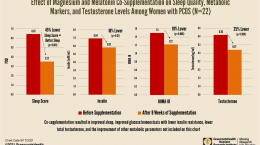Published on January 14, 2022
Video Friday: Melatonin is a powerful antioxidant with many health benefits. Learn how you can trigger your cells to make their own melatonin…
Key Points
- Melatonin has been shown to have antioxidant and anticancer effects, to play a role in the regulation of blood pressure and glucose levels, is highly anti-inflammatory, and has also been shown to lower the risk of SARS-CoV-2 infection and mortality
- Melatonin exists in two main forms within the body – circulatory melatonin, which is produced by the pineal gland and has its major effect on sleep and the circadian rhythm, and subcellular melatonin, which is produced and used locally by the mitochondria within our cells
- Production of melatonin can be triggered through exposure to the infrared spectrum of light – sunshine is our major source of infrared light, but it can also come from exposure to fire (campfire, candle flames, fireplace, etc.) and some red-light therapy
 Melatonin is a powerful anti-oxidant, and as discussed in the video below, could even be considered more powerful than the “Master Antioxidant” glutathione, which was reviewed in our last post here. Melatonin has been shown to have anticancer effects and to play a role in the regulation of blood pressure and glucose levels. It is also highly anti-inflammatory, with an extensive list of physiological actions that go well beyond sleep and circadian rhythm regulation. Studies have also shown a lower risk of SARS-CoV-2 infection and lower mortality due to COVID-19 disease among patients taking melatonin.
Melatonin is a powerful anti-oxidant, and as discussed in the video below, could even be considered more powerful than the “Master Antioxidant” glutathione, which was reviewed in our last post here. Melatonin has been shown to have anticancer effects and to play a role in the regulation of blood pressure and glucose levels. It is also highly anti-inflammatory, with an extensive list of physiological actions that go well beyond sleep and circadian rhythm regulation. Studies have also shown a lower risk of SARS-CoV-2 infection and lower mortality due to COVID-19 disease among patients taking melatonin.
Trigger the Production of Your Own Melatonin through Exposure to Sunlight
Most health experts suggest avoiding long-term supplementation with melatonin, however, there is a natural way to get your body to produce its own on a regular basis, without supplementation. Vitamin D and melatonin are both highly affected by exposure to sunlight; the same day-time sun exposure that produces vitamin D can also boost melatonin production!
According to a new hypothesis presented by Zimmerman, S. and Reiter R. and reviewed in the video below, melatonin exists in two main forms within the body – circulatory melatonin, which is produced by the pineal gland and has its major effect on sleep and the circadian rhythm, and subcellular melatonin, which is produced and used locally by the mitochondria within our cells.
Sounds quite a bit like how our bodies produce and use vitamin D, right? Could melatonin be another hormone product of sunlight that has additional non-hormonal health-benefits within the body? Watch the video below to learn and ponder more!
Watch the Video
After watching the video, be sure to make note of the details below.
Video Summary: The MOST POWERFUL Antioxidant is Melatonin, NOT Glutathione
The body is built to protect itself against free radical damage and inflammation utilizing a network of antioxidants
Melatonin is recognized as a powerful antioxidant, and it stimulates other antioxidants, including glutathione
Melatonin is good for sleep, immune modulation, protection against certain viruses, is anti-inflammatory and anti-cancer
Two forms of melatonin exist in the body – circulatory (produced by the pineal gland), and subcellular (produced inside the cells and mitochondria); the majority of melatonin in the body is subcellular
Melatonin is especially protective of the brain; is it possible that sundown syndrome, experienced by approximately 45% of individuals with Alzheimer’s Disease or dementia, could be related to a depletion of melatonin?
Absence of light stimulates production of melatonin from the pineal gland, however, the largest stimulus of subcellular melatonin is near infrared light (sunshine is the greatest source!)
Over 50% of sun’s energy is infrared; campfires, fireplace, candles, and incandescent lights also emit infrared light, as do infrared saunas and lasers
Antioxidants can be produced from exposure to the sun!
“As a therapy, being outside in the environment, in nature, and being exposed to sun, is extremely important, probably just as important as eating healthily.”
Infrared light has the ability to penetrate the skull and access the cerebral spinal fluid, a reason why those with Alzheimer’s and dementia especially should get more sun
Infrared light helps protect against UV damage
Deficiency of infrared can result from excessive exposure to artificial light, LED, blue light (cell phones, computers); studies have shown that blue light has the strongest effect on the suppression of melatonin secretion upon exposure to the eyes
Trigger your mitochondria to make their own melatonin through exposure to the infrared spectrum of light – from the sun, fire (campfire, candle flames, fireplace, etc.) or using some red-light therapy
Sunlight Induces the Production of Many Beneficial Chemicals in the Body
Sunlight produces much more for our health than just vitamin D from ultraviolet-B exposure; multiple types of energy are emitted from the sun, including red, near infrared, far infrared, and blue light, each of which offers some unique health effects. Another of the many benefits of sun exposure is the short-term release of nitric oxide when the skin is exposed to the sun’s UVA rays. Nitric oxide is beneficial for heart health by acting to increase blood flow and lower blood pressure. Additionally, nitric oxide plays a key role in immunity, cellular function, neurotransmission, and has antimicrobial and anticancer effects.
Sunlight exposure also results in the production of serotonin and beta-endorphins, which promote mood enhancement and relaxation, relieve pain, and boost immunity. There is also evidence that vitamin D itself may help regulate the production of both serotonin and melatonin.
Start incorporating regular sunshine exposure into your daily routine to increase your body’s production of vitamin D, melatonin, and other health-boosting chemicals.
Supplements Do Not Provide Everything that the Sun Does for Our Health
The above information provides just a glimpse at the complex relationship between our bodies and the sun, and highlights how the sun provides many health benefits. However, for most people sun exposure alone is not enough to achieve the target range for vitamin D of 40-60 ng/ml. Vitamin D3 supplements are a good secondary source of vitamin D when direct sunlight isn’t available or not strong enough to make sufficient vitamin D.
Measuring Your Vitamin D Level is One Way to Tell if You Are Getting Enough Sunshine
 Having and maintaining healthy vitamin D levels and other nutrient levels can help improve your health now and for your future. Choose which to measure, such as your vitamin D, omega-3s, and essential minerals including magnesium and zinc, by creating your custom home test kit today. Take steps to improve the status of each of these measurements to benefit your overall health. You can also track your own intakes, symptoms and results to see what works best for YOU.
Having and maintaining healthy vitamin D levels and other nutrient levels can help improve your health now and for your future. Choose which to measure, such as your vitamin D, omega-3s, and essential minerals including magnesium and zinc, by creating your custom home test kit today. Take steps to improve the status of each of these measurements to benefit your overall health. You can also track your own intakes, symptoms and results to see what works best for YOU.
Enroll and test your levels today, learn what steps to take to improve your status of vitamin D (see below) and other nutrients and blood markers, and take action! By enrolling in the GrassrootsHealth projects, you are not only contributing valuable information to everyone, you are also gaining knowledge about how you could improve your own health through measuring and tracking your nutrient status, and educating yourself on how to improve it.





